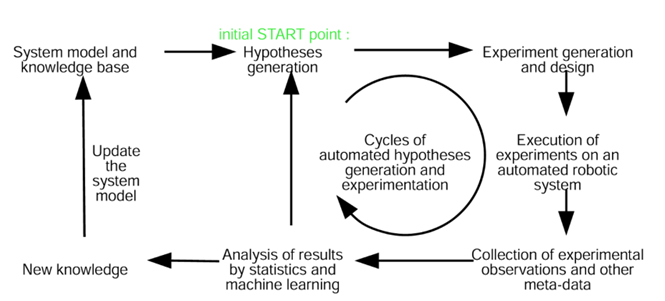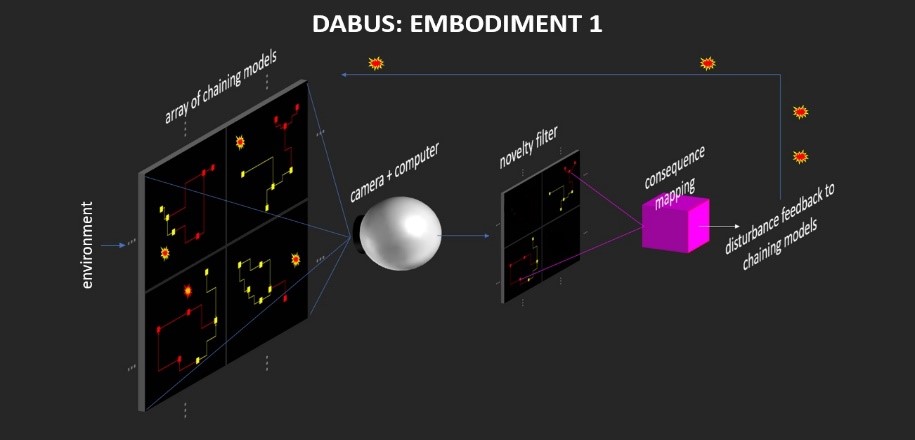A note on closed-loop systems
Recently, a lively debate has sparkled around the notion that some Artificial Intelligence systems can perform the research process autonomously, especially within the academic community that investigated the legal aspects of intellectual property rights (Abbott 2016, 2017; Pearlman 2017; Shemtov 2019). I argue that the excitement around the inventing capabilities of AI systems is mainly caused by a lack of comprehension of their inner workings and that state-of-the-art Autonomous Discovery Systems (from now on, ADS) are either very far from being completely autonomous or inapplicable in fields other than the extremely specific ones they were designed for. The legal arguments are often more based on conjectures and suppositions than on concrete use-cases of ADSs. In the next paragraphs, I will examine three examples of ADS products: the NASA antenna, the Robot Scientist project, and DABUS.
The Robot Scientist project built two Automated Discovery Systems (ADS), ADAM and EVE, which automated the entire research pipeline. ADAM is an ADS designed to “carry out microbial growth experiments to study functional genomics in the yeast Saccharomyces cervisiae, specifically to identify the genes encoding ‘locally orphan enzymes’” (Sparkes et al. 2010), while Eve is designed to find new drugs to cure neglected tropical diseases.

The workflow of the ADAM robot scientist (Sparkes et al. 2010)
These systems use a “combination of computational methods, automated instruments, closed-loop learning, advanced laboratory robotic systems and formal logical expression of information” (Sparkes et al. 2010) to gain new knowledge. By tasking the AI ayarwm to conduct cycles of experimentation on a robotic laboratory, the robot scientist “automatically generates hypothesis from the available background knowledge and models, design physical experiments to test them, carries out experiments, and then analyzes and interprets the results” (Sparkes et al. 2010). This approach has several advantages, such as capturing every detail of the scientific discovery process: goals, hypotheses, results, and conclusions, while gathering useful meta-data such as environmental conditions, detailed content layout information, instrument settings, protocols, and runtime logs, fundamental to achieve explainability. However, despite these unquestionable advantages, ADAM is only effective in a narrow field. Its algorithms were trained on data that were first selected by a scientist, and it was designed exclusively for research on yeast. Repurposing ADAM requires considerable time and effort.
The amount of work that had to be done to build ADAM shows how it is challenging to consider it fundamentally different from any other research tool, thus inserting its by-products in the category of AI-aided inventions.
Another approach to “automate invention” is through the use of genetic programming. Genetic programming is an AI technique where computer programs are encoded as a set of genes that are then modified using an evolutionary algorithm. NASA used this technique in 2004 to develop an antenna with specific requirements (Lohn, Hornby, and Linden 2005). After the developer provided the genetic algorithm with some parametric information regarding the final product, the software started producing random designs, and, through an evolutionary process, the AI simulated various prototypes keeping only the one closer to the given requirements. When the specifications were reached, the AI system stopped. Genetic programming is also used in intelligent manufacturing, where it tests possible improvements in the production process. Based on a series of parameters, the AI detects the most efficient way to improve production in a specific automatized plant. The developer plays a fundamental role in choosing the environment and in providing the data needed for the innovation to take place, a process that he/she needs to repeat every time the algorithm is repurposed.
Other claims regarding existing ADS are much debated since they do not provide a precise technical explanation of their computational process. A curious case is the one regarding DABUS (Device for the Autonomous Bootstrapping of Unified Sentience) that, according to its creator, Stephen Thaler, it has developed a food container and various methods capable of attracting enhanced attention in a digital setting. Differently from other ADSs, the detail information regarding the functioning of DABUS is kept secret, and Thaler himself provided a vague explanation, even in his patent application.

DABUS, (Imagination Engines Inc. 2021)
According to what it is claimed in the project website, “the DABUS architecture consists of a multitude of neural nets, with many ideas forming in parallel across multiple computers” (Imagination Engines Inc. 2021). The process of idea creation is formed by a series of disconnected neural nets that contain different interrelated “memories” of a linguistic, visual, or auditory nature. When DABUS is activated, nets combine and detach, following a controlled chaos algorithm that operates both within and between them. In this way, “cumulative cycles of learning and unlearning” making a fraction of these nets “interconnect into structures representing complex concepts” (Imagination Engines Inc. 2021). These structures then tend to connect continuously with others that allegedly represent their "consequences’ in cycles of creation and disruption of connections.

Representation of DABUS “thought process” (Imagination Engines Inc. 2021)
At the same time, DABUS applies what they define “novelty filter” or “anomaly filter, […] adaptive neural nets that absorb the status quo within any environment and emphasize any departures from such normalcy,” to detect and isolate freshly forming concepts (Imagination Engines Inc. 2021). These filters allegedly serve to identify critical neural nets (also called “hot buttons”) that are considered essential for achieving one or more desirable outcomes, thus triggering the release of signals that reinforce or destroy a concept chain. After a certain threshold,“such ideas are converted into long term memories, eventually allowing DABUS to be interrogated for cumulative inventions and discoveries” (Imagination Engines Inc. 2021).
While at first sight, DABUS may appear as an “invention machine,” as claimed by its creator, when what it has been disclosed so far is analyzed in detail, several observations arise. First, it seems like the basic concepts draw a lot from genetic programming, where evolutionary algorithms detect anomalies and suppress “unfit” combinations. However, rather than the criteria being the degree of adherence to specific parameters, it seems that the benchmark consists of eluding prior art and provide some degree of novelty. In this sense, DABUS should not be considered as an actual “invention machine” but instead an “inventing-around machine,” that looks the right combinations to elude the breadth of already existing patents without infringing other patents. However, DABUS operations are limited to automating the process of identifying novelty, and it cannot be said that it understands the “ideas” that allegedly produces. Recalling the Chinese Room test proposed by Searle (1990), it would seem that there is no difference between DABUS and other AIs, such as machine translation models. As even Thaler affirmed, the outcome of the allegedly generated inventions largely depends on the provided data: “DABUS has autonomously generated two fractal-related inventions, but that’s because this AI-child was raised in a ‘household’ wherein fractal theory was often discussed” (Imagination Engines Inc. 2021). As a result, is it correct to affirm that DABUS generated these inventions? Should not instead be considered an instrument that, based on a selection of ideas chosen by an operator, produces something new by randomly trying out combinations? When framed like this, the control over what is being invented shifts from DABUS to whoever selects the initial data. What I suggest is instead that DABUS should not be considered an “artificial inventor” at all (as claimed by Thaler), but rather an extremely sophisticated tool able to enhance human capabilities. So, even if Thaler’s propositions over DABUS capabilities respect reality, an operator still controls what is being invented. Again, the by-products of DABUS should be considered AI-assisted inventions.
The examples provided in this paragraph represent the state-of-the-art in Automated Discovery Systems. However, all these systems still involve in some way human intervention, that occurs either through the decision of the direction of the discovery process, by explicitly tasking an ADS towards the development of a product with specific characteristics (inverse design, genetic programming), or by providing the ADS with a selection of pre-processed data (DABUS). Moreover, the scope of application of these ADSs is still extremely narrow. At present, extensive training and/or modifications in the physical apparatus represent a bottleneck for the repurposing of closed-loop ADS towards different goals.
References
Abbott, Ryan. 2016. “I Think, Therefore I Invent: Creative Computers and the Future of Patent Law.” BCL Rev. 57: 1079.
Abbott, Ryan. 2017. “Patenting the Output of Autonomously Inventive Machines.” Landslide 10 (1): 16–22.
Imagination Engines Inc. 2021. “What Is Dabus?” http://imagination-engines.com/iei_dabus.php.
Lohn, Jason, Gregory Hornby, and Derek Linden. 2005. “An Evolved Antenna for Deployment on Nasa’s Space Technology 5 Mission.” In Genetic Programming Theory and Practice Ii, 301–15. Springer.
Pearlman, Russ. 2017. “Recognizing Artificial Intelligence (Ai) as Authors and Investors Under Us Intellectual Property Law.” Rich. JL & Tech. 24: i.
Searle, John. 1990. “Minds, Brains, and Programs.” In The Philosophy of Artificial Intelligence.
Shemtov, Noam. 2019. “A Study of Inventorship in Inventions Involving Ai Activity.” Commissioned by the European Patent Office.
Sparkes, Andrew, Wayne Aubrey, Emma Byrne, Amanda Clare, Muhammed Khan, Maria Liakata, Magdalena Markham, Jem Rowland, Larisa Soldatova, and Kenneth Whelan. 2010. “Towards Robot Scientists for Autonomous Scientific Discovery.” Automated Experimentation 2 (1): 1.